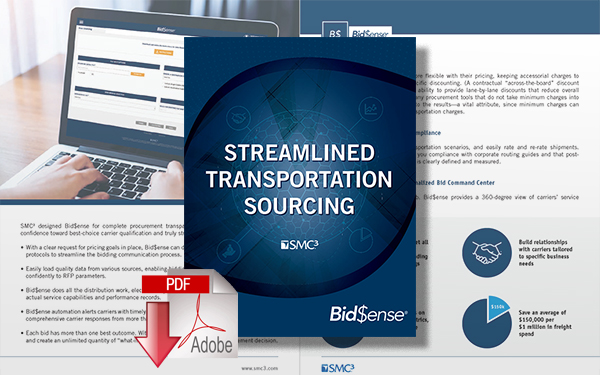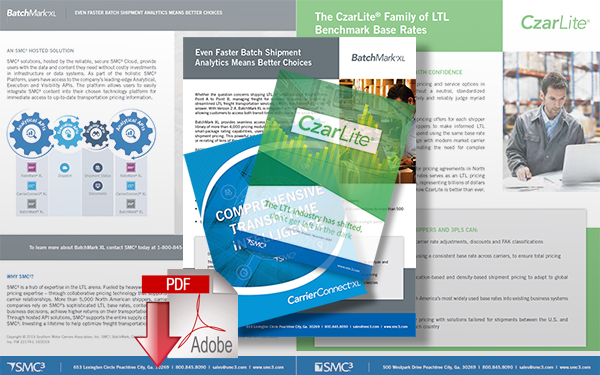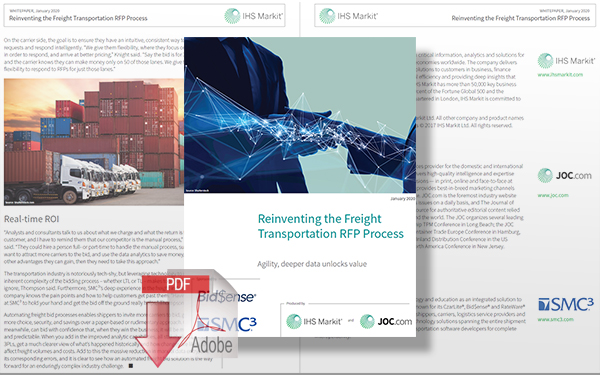Three Bidding Strategies to Maximize Performance in a Tight Freight Capacity Market

Shippers can no longer rely on the old rules of freight transportation procurement like manual spreadsheet RFPs and annual bids and continue to thrive in a market defined by rapidly fluctuating transportation costs and capacity demands.
COVID-19 Pandemic Impact on LTL and Truckload Freight
As we entered 2021, the impact of the pandemic on LTL and truckload freight was still coming into focus. Now, 16 months later from the pandemic’s abrupt arrival on the global stage, many of the long-tail effects of disrupted supply chains, closed ports of entry, and component shortages are becoming clearer.
Many experts predicted tight capacity and driver shortages would begin to loosen as the second half of 2021 continued. It is now becoming clear that sky-high consumer demand and growing comfort with e-commerce channels have significantly changed the frequency and volume of freight activity in long-lasting ways. In fact, according to recent data from IBM’s U.S. retail index, the pandemic accelerated the shift to e-commerce shopping by roughly five years, creating a surge of activity that is unlikely to fade even after the pandemic shifts into the rearview mirror.[1]
As a result, shippers can no longer rely on the old rules of freight transportation procurement - like manual spreadsheet RFPs and annual (or biennial) bids - and continue to thrive in a market defined by rapidly fluctuating transportation costs and capacity demands. At the center of the problem is a greater need for shipper flexibility and agility to capitalize on available capacity and improve overall supply chain efficiencies.
In order to build out best-in-class bidding strategies, both supply and demand-side organizations need to invest in the right set of bidding and procurement tools to set them up for long-term success. Here are three strategies shippers can adapt to keep up in the rapidly evolving supply chain ecosystem.
1. Benchmark rates and conduct procurement exercises regularly. Comparing last year’s transportation rates to this year’s is helpful, but shippers also need to know how their rates compare to the broader market at the moment. Benchmarking tools can help enable a shipper to take advantage of historical insights to chart a course for the prices they should expect to pay moving forward.
[1] COVID-19 pandemic accelerated shift to e-commerce by 5 years, a new report says
At the same time, shipper needs are bound to change over time - especially as they attempt to stabilize their e-commerce demand from consumers. While many shippers will attempt to lock in long-term contracts at what seems to be a low rate, especially in a highly volatile market, that same volatility means shippers need to continue providing the right set of data points to get accurate prices and confidence service.
Using tools like SMC³’s BidSense® enables shippers to engage a broad range of carriers, helping to gauge the offers of existing carriers against other providers to find the best deal amid a rapidly changing market rate.
2. Build strong partnerships with a network of service providers. As long as capacity remains tight, shippers will continue to find themselves in a competitive market as they jockey for space and access to carrier equipment. For this reason, it’s important that shippers make themselves valuable business partners. There are a few ways shippers can accomplish this goal.
First, they can help streamline the RFP process by using digital bidding tools and automated form-fills that supply the full spectrum of freight data carriers needed to precisely cost, quote, and allocate equipment on the first ask.
Second, they can focus on providing accurate information that reflects the true cost of carrying their freight. Providing the correct weight and dimensions along with advance warnings of likely service requirements, such as liftgate and residential deliveries, can simplify contract negotiation and make your organization a 5-star shipping partner.
Bid$ense from SMC³ is a viable means of engaging new carriers, even if you don’t already have a relationship with them, because it connects your procurement teams directly with carriers’ pricing teams to eliminate friction and focus on the best option for your freight.
3. Use a cloud-based bidding tool to bid regularly, move fast and cast a wide net. The most important step to begin adapting in a tight market is also the most obvious one: When capacity is scarce, cast a wide net to many potential carrier partners. That’s not changing any time soon – but the way shippers strategize and execute bids definitely is.
Among the trends accelerated by the COVID-19 pandemic is an appetite for “mini-bids,” short-term revisions to contracts that last between three and six months. Mini-bids (sometimes called “micro-bids”) is gaining traction as a way to secure capacity in specific lanes or regions without relying on the spot market. Engaging in a subscription-based model, available through SMC³, can make the min-bid process easier, and provides flexibility to the shipper. Coupled with what some see as the growing obsolescence of the traditional RFP process, the increasing acceptance of mini-bids favors – or requires – up-to-date insights and the tools to make quick, smart, data-driven bidding decisions.
Use the Right Tools for Today’s Rapidly Changing Market
There’s value hidden in the time your transportation division spends on bidding. The secret to evolving the bidding process from a burden into business advantage is using the right tools to manage it.
The customized SMC³ Bid$ense solution, for example, can be set up by the SMC³ data services team, ensuring that a shipper is able to use data that has been cleaned, analyzed, and aggregated to maximize value. As a result, shippers can move faster to lock in sourcing pricing quickly and greatly reduce shipping costs - on average, Bid$ense users save $150,000 per $1 million in spending.
Want to see how Bid$ense can help your organization navigate a tight capacity market? Head over to our product page to learn more about the SMC³ Bid$ense tool or contact one of our customer service representatives to schedule a Bid$ense demo.
Related Papers
Bid$ense: Streamlined Transportation Sourcing
This paper details how using Bid$ense leverages SMC³’s lifetime of transportation purchasing knowledge, allowing customers to incorporate pricing, claims ratios, on-time performance, and transit times into their LTL bidding analysis. Download Now!
Analyzing and Predicting Freight Transportation Costs
In these 3 resources, BatchMark XL, CarrierConnect XL, and CzarLite, we detail how to ensure accurate freight billing across every carrier agreement, uncover potential freight bill invoice errors, and assist with price negotiation and planning. Download Now!
Reinventing the Freight Transportation RFP Process
In this white paper, we describe how using a tech-enabled freight bid system allows for more freight providers to be considered, greatly improving choice and the ability to tailor your service around more than just price. Download Now!
More SMC³ Resources
Related Article: What Is A Freight Bill Audit, and Why Do You Need One?
Article Topics
SMC3 News & Resources
SMC3 Mercury Gate Case Study - Improving Workflows and Enhancing Efficiency with LTL APIs SMC3: Is Technology a Competitive Advantage in the Modern Supply Chain Industry? Armada’s Prather examines the disconnect between the freight economy and the macro economy at SMC3 JumpStart 2024 SMC³’s Solution to the Logistics Industries Talent Problem 2024 Transportation Rate Outlook: More of the same? Refining LTL API Consumption for Optimal Efficiency and Enhanced Services Regulations Impacting Less-than-Truckload More SMC3Latest in Transportation
FedEx Announces Plans to Shut Down Four Facilities The Two Most Important Factors in Last-Mile Delivery Most Companies Unprepared For Supply Chain Emergency Baltimore Bridge Collapse: Impact on Freight Navigating Amazon Logistics’ Growth Shakes Up Shipping Industry in 2023 Nissan Channels Tesla With Its Latest Manufacturing Process Why are Diesel Prices Climbing Back Over $4 a Gallon? More Transportation

















